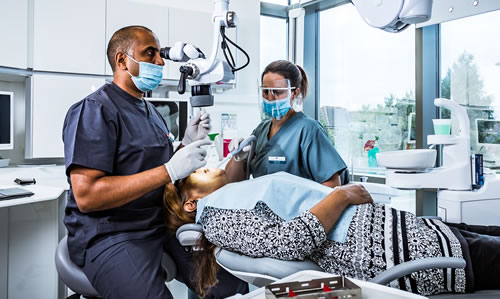What Happens When A Tooth Dies?

Root canal treatment – saving infected teeth in Bedford
Your teeth are natural living complex structures and not just a solid block of enamel as some people believe. Essentially, there are three parts to a tooth; the external enamel layer, the softer dentin layer beneath it and the root canals of the teeth which contain nerves and blood vessels. With good care, teeth can thrive and remain healthy for a very long time.
Even if we take excellent care of our teeth, brushing, flossing, seeing the dentist, having them cleaned by the hygienist etc, they can still be affected by events in our life. Where a tooth suffers a traumatic event such as a heavy blow from a fall or similar, the tooth may not break, but the impact can cause the tooth to die.
A dead tooth
You don’t necessarily feel any initial pain when a tooth dies, other than from any impact of course. As it dies though, the once living tissues in the roots of the tooth start to decay. Infection and pressure starts to build up within the hollow canals of the tooth, often causing a great deal of pain. Rather then allowing it to reach this stage, we always recommend that our Bedford patients come to see us if they are concerned about receiving a blow to a tooth. We can x-ray the tooth, and where needed, treat it before any pain sets in.
Root canal treatment
There is only one way to save a tooth that has become affected in this way, and that is through root canal treatment. Despite any rumours you may have heard, we can assure you that a root canal procedure will be nothing like as uncomfortable as you may have been led to expect. At The Dental Centre Bedford, we have modern equipment and experienced specialists dentists to ensure that you receive the treatment as comfortably and professionally as possible.
Although it is an invasive procedure, the local anaesthetic given will numb the area of the procedure and any discomfort should be minimal. Our dentists will also make sure that you are comfortable during the procedure and will give instructions as to how to signal if you need to take a short break during the treatment.
To preserve the tooth, it is necessary to remove the infection, clean and fill the infected canals. This may involve the removal of the top of the tooth to allow clear access. Once the tooth has been cleaned and filled, it is usually completed using a crown. This not only creates a natural appearance but also strengthens the tooth, sufficient for daily use.
Here at The Dental Centre Bedford we will keep you fully informed about your treatment and what it involves, so if there are any treatments you would like to know more about, please let us know and we will try to cover that in a future blog. You can contact us via the website or simply call us on 01234 819868.
